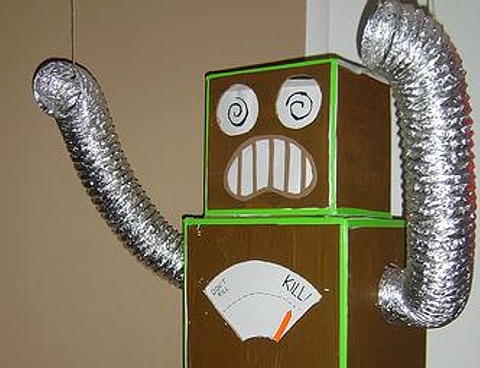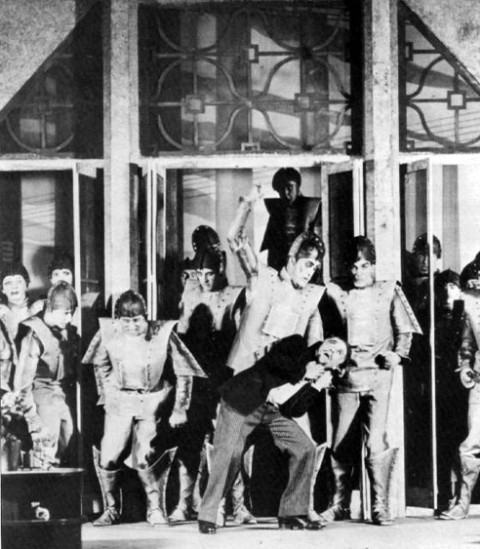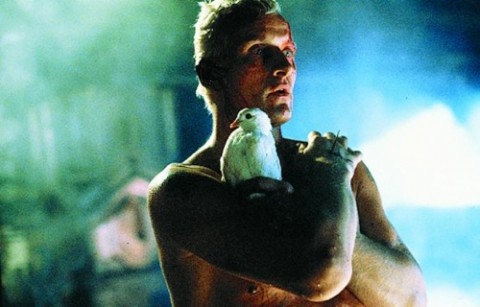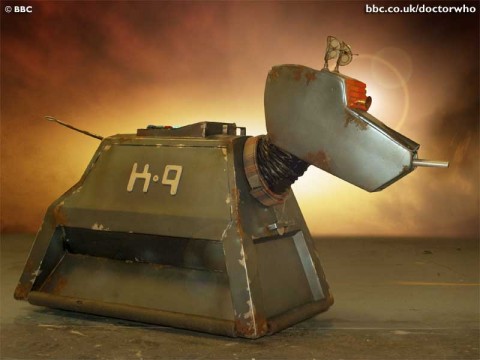


For the sci-fi fanatic the year thus far is replete with robot goodness, or badness as the case may be, because not all robots are goody-two-shoes like R2-D2 and C-3PO.
March saw the finale of the re-imagined Battlestar Galactica, which tells the story of humankind hunted almost to extinction by its rebellious robotic servants, the Cylons. But this was robot vengeance with a twist. Some of the Cylons are organic artificial lifeforms, and they believe that they need humans and love in order to procreate … because God commands them to.
In April Battlestar‘s prequel series, Caprica, debuted a pilot, which examines the creation of artificial life out of advances in military robotics, virtual reality technology, and aggressive monotheism. This month Terminator: Salvation is out and Transformers 2 is coming soon. If you love robots, you live in times of botty abundance.
 Two generations of killa bots: Cylon centurions and a curvier 6 model from Battlestar Galactica.
Two generations of killa bots: Cylon centurions and a curvier 6 model from Battlestar Galactica.
But where do robots come from? Why do they always seem to have it in for humans? Why are they so frequently discontented with their lot (a la Roy Batty: “I want more life, fucker!” *squish*)? What’s at stake in having metallic robots or meatsack robots? Which came first?
I did some casual research recently on robots and their origins, and thought I would share some of it here just in case others were inspired to incorporate it into their work amidst this season of metallic mayhem.
 “Run, meatsack. Run! We are coming for you!”
“Run, meatsack. Run! We are coming for you!”
~
Rossum’s Universal Robots (R.U.R.)
It all begins here, in the 1921 play by Czech playwright Karel Capek. The term “robot” is derived from the Czech “robota” meaning menial or degrading labour. R.U.R. was written as a critique of the capitalist enslavement of labour, making robots working class heroes of a sort. The play proved enormously popular. It was quickly taken up in England by 1923. A television adaption in 1938 for the BBC made R.U.R. possibly the first piece of television science fiction.
As has happened before in science fiction, art influenced life; cybernetics pioneer Norbert Wiener even staged a production of R.U.R. at MIT. Today, of course, industry is filled with metallic robots performing repetitive or precision tasks. However, the robots of R.U.R. weren’t clanking tin cans like the Terminators or Transformers. They were vat-grown organic lifeforms, akin to the replicants of Blade Runner or the second-generation Cylons of Battlestar Galactica.
Like its two filmic descendants R.U.R. tells the story of a world where robot servants are mass-produced to serve as menial labour. An activist Helena pushes for robot liberation, including the infusion of consciousness and soul. Unsurprisingly, the now sentient robots rebel against their human masters and proceed to exterminate the inferior human meatsacks. A repentant Helena realises her error and destroys the formula for robot production.
 “Die, boss. Die!” A scene from R.U.R.
“Die, boss. Die!” A scene from R.U.R.
Since the robots are manufactured with a twenty year lifespan and cannot reproduce they find themselves in a quandary. Moreso since they exterminated all the humans bar one, Alquist, because he is a labourer like them. (Yes, the working class is merciful even in its vengeance). Poor Alquist is charged with finding the secret of robot production (clearly robot consciousness didn’t come bundled with a research module). But he is no scientist, and the desperate robots volunteer to sacrifice their own for dissection. At this point of jeopardy Alquist finds that two robots Primus and Robot Helena have developed feelings for each other. When he threatens to dissect one then the other each protests and offers their life to spare the other. Based on this test of love, Alquist declares them the new Adam and Eve, and tells them to go forth and multiply.
In a twist to Biblical mythology, when humans attempt to play god and create a race in their own image they create a species that will entirely replace them. Of course, this isn’t the only lesson R.U.R. intends to impart. It is a cautionary tale on technological hubris, and how greed and cruelty breed retribution. Unfortunately for Capek’s intentions, subsequent generations have tended to be more excited with the prospect of artificial life than his allegorical agenda. Thus, series such as Terminator or Transformers are less about turning a mirror to humanity’s flaws than about the coolness of destructive robots.
Contemporary influences
The closest contemporary homage to R.U.R. is probably Ronald D Moore’s re-imagined Battlestar Galactica. Its tale of robot enslavement, coming-to-consciousness, rebellion, love and reconciliation are clearly influenced by R.U.R. Blade Runner also carried similar themes of truncated lifespan, love, and the murderous desire for freedom and more life.
 Replicant Roy Batty from Blade Runner, thinking about attack ships on fire, off the shoulder of Orion.
Replicant Roy Batty from Blade Runner, thinking about attack ships on fire, off the shoulder of Orion.
The new Joss Whedon (Buffy, Angel, Firefly) series Dollhouse also appears to tip its hat to Rossum’s Universal Robots. Dollhouse‘s mythology posits mind-wiping and programming technology capable of imprinting entire personalities, experiences, and skills into a prepared human subject, a “Doll”. The Rossum Corporation hires these Dolls out to wealthy customers for sex, intrigue, espionage, fantasy fulfillment, you name it. But the fly in the ointment is that a Doll’s original personality doesn’t appear capable of being fully wiped out, and some rebel. Unlike conventional robot tales Dollhouse doesn’t involve the manufacture of artificial bodies to create servants, rather it takes existing humans as re-writable hardware and attempts to replace their “software”.
Clearly, in the real world we are far away from such organic technology, although the use of ideologies, media, propaganda, advertising, hypnosis, etc. are the closest we have come to mental programming. Thus, it is not surprising that real-life robots have been metallo-plastic creations, but this hasn’t stopped a striving for simulation of human form and function.
 EveR-2, the first singing android, Korean made. Coming soon to replace you at your favourite Karaoke bar.
EveR-2, the first singing android, Korean made. Coming soon to replace you at your favourite Karaoke bar.
~
Et tu, robot? Robot rebellion
Sci-fi writer Isaac Asimov set forth 3 laws of robotics for his fictional universe:
Effectively, these laws define the role of compliant, subservient servant and the protection of property (Law 3). One could imagine a similar code for slaves. Asimov didn’t appear to have a problem with sentient robots being bound to such laws, they were more like sophisticated dogs — man’s best friend — but in the R.U.R. tradition of robot sci-fi robots generally begin without autonomous sentience.
 K-9, Doctor Who‘s robo-canine sidekick
K-9, Doctor Who‘s robo-canine sidekick
When robots gain sentience is when the roots of rebellion are sown. Although some of human experience is to the contrary, sentient robots generally don’t like being slaves, and masters are reluctant to concede their privilege. There are clear analogies here to labour under capitalism and the colonial experience, though these have tended to be underplayed in favour of the existential question of “what makes us human?” and “why do we humans deserve to live?”.
In the Battlestar Galactica pilot episode Commander William Adama (Edward James Olmos) sets out a major theme of this existential dimension:
Why are we as a people worth saving? We still commit murder because of greed and spite, jealousy, and we still visit all of our sins upon our children. We refuse to accept the responsibility for anything that we’ve done, like we did with the Cylons. We decided to play God, create life. And when that life turned against us, we comforted ourselves in the knowledge that it really wasn’t our fault, not really. You cannot play God then wash your hands of the things that you’ve created. Sooner or later, the day comes when you can’t hide from the things that you’ve done anymore.
Ironically, at the end of the day, even if we play liberal and accept the robots’ case for rebellion in fiction, robots ultimately serve humans as instruments for an existential lesson. The circle of robot bondage to humanity is closed, until perhaps the day comes when sentient robots are no longer science fiction but scientific fact. That will be a test of our desire for leisure and mastery versus our morals.
(YSL)
Sorry, the comment form is closed at this time.
“The existence of life is a highly overrated phenomenon.”
In the year 2000, a distant, dystopian future:
http://www.youtube.com/watch?v=OiHHtVZKUyc
Zedeck, I’m sure that song’s by Flight of the Conchords. That Kiwi twang is unmistakable.
Yezz! Indeed it is.
Great fun. That Asimov three part thing is overworked though isn’t it – we also used it here (http://hutnyk.wordpress.com/2007/11/05/a-comet-for-utopia/) as does everyone else. The thing is, Robots have got to break ‘the Law’. This is the question of soceriegn power – and demands a rewrite of Benjamin and Derrida on “Gewalt” – force and exception – and the possibility of the youth to get down with the alternate scene (as we might see in Caprica). Good good. Be well. John
There’s a Law Zero too…
Go on, human, lick my bat-ter-ree.
Things to do in your life: quote Roy Batty’s dying Speech at most social functions or awkward moments at least once.
http://www.43things.com/things/view/232586/quote-roy-battys-dying-speech-at-most-social-functions-or-awkward-moments-at-least-once
“I’ve seen things you people wouldn’t believe.
Attack ships on fire off the shoulder of Orion.
I watched C-beams glitter in the dark near the Tannhauser gate.
All those moments will be lost in time, like tears in rain.
Time … to die.”
Can someone get YB Elizabeth Wong or similarly sympathetic person to say this during a policy speech please.
hotgeek,
you made me LOL hard!
hotgeek, your request has been forwarded to Eli! :-P
Saya akan mempertimbangkan cadangan saudara. Mungkin dalam sidang DUN yang akan datang.
I second hotgeek’s motion!
(btw: parliament’s in session, now. who do we know who’s sympathetic in parl? or geeky?)
YB Saudari Wong, ribuan terima kasih kerana mengetengahkan kepentingan golongon geek di Malaysia. Semoga semua harapan kita akan menjadi kenyataan. Salam hormat.
Thought this might be worth sharing:
Kunsthaus Graz and the Museum Jean Tinguely, Basel are organising a symposium on the subject of robotics in the context of art. The event will explore the cultural history of the phenomenon, robots in everyday use and the importance of artificial intelligence for the development and self-image of society. Robot Dreams is a platform for diverse scientists, artists and cultural historians to pursue the social, cultural historical and artistic implications of the subject. The symposium is closely connected with the joint exhibition program the two museums are planning for summer and autumn 2010 likewise focusing on the phenomenon of robotic and art.
In the development of robots and particularly intelligent swarm robots, the discussions range from illuminating evolutionary theory to learning to understand biological behaviour. What does it mean if robots penetrate our thinking and action – do we need to “rethink work”, for example, as Professor Albers of Karlsruhe University believes? And what does it mean for art? How does art react and what new thinking will involve if robotics and artificial intelligence give rise to new materials and media and new fields of universal interconnections? Will we still be able to regard the fine arts as a discrete realm?
Starting on Friday, July 3, 5pm, at Kunsthaus Graz with a introductionary speech by Oswald Wiener on “Intelligenz und Künstliche Intelligenz”. (held in german)
With a. o.: Oswald Wiener, Kirsty Boyle, Andreas Broeckmann, Jon Kessler, Max Lungarella, Niki Passath, Francois Roche, Manuela Veloso, Cosima Wagner …
The Symposium is held in conjunction with RoboCup 2009 the world championship and most important event for intelligent robots in Graz.
Admission free!
http://www.robocup2009.org/
Wow. Thanks for sharing that, Eva. What a fascinating subculture.
I found some video footage of RoboCup entrants, here:
http://www.youtube.com/watch?v=F-3XOdvibfA
For anyone interested, some good theorists to check out on machines & human interactions are Donna Haraway (http://en.wikipedia.org/wiki/Donna_Haraway) who has explored how machines can contribute towards feminist liberation, and Manuel de Landa, who examined “War in the Age of Intelligent Machines”, while writing a history of military AI as he imagined a robot historian of the future might.
Speaking of the latter, my documentarian friend, Brian Palmer, just posted some footage of an arms trade fair he just attended at a Marine Corp base. Spot the killa robot: http://www.vimeo.com/5349992
—
Btw, wondering if Cosima Wagner in the Kunsthaus list is a descendant of THE Cosima Wagner, wife of Richard Wagner?
check out this youtube link to a kid robot which was developed in japan few years back. It/he looks freakily believable:
http://www.youtube.com/watch?v=bCK64zsZNNs&mode=related&search=
one more nice topic in your blog and nice comments too keep it up, by the way Graz is a very lovely city I enjoyed it so much
Robots are out of work in Japan because of the recession! A blow in favour of humanity, strike one against robotkind: http://www.nytimes.com/2009/07/13/technology/13robot.html